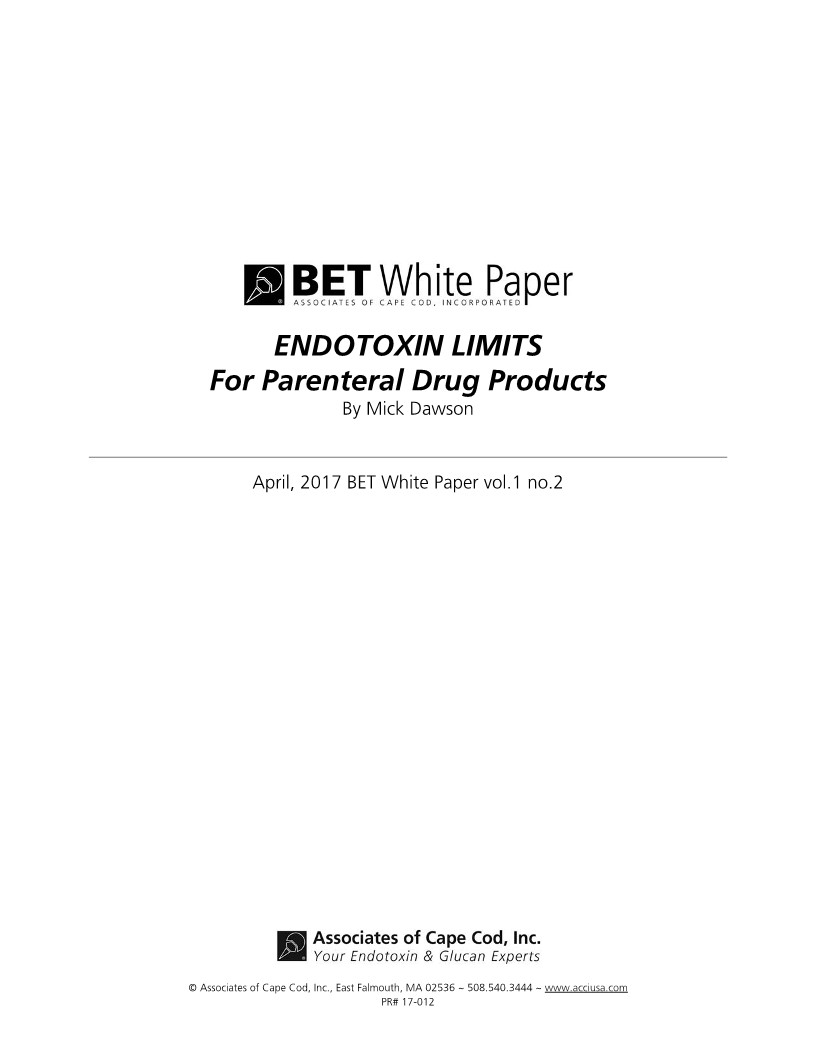肠外药物产品的内毒素限值
- 分类:新闻资讯
- 作者:Mick Dawson
- 来源:科德角国际
- 发布时间:2023-03-15 11:44
- 访问量:
【概要描述】Endotoxin Limits For Parenteral Drug Products - By Mick Dawson
肠外药物产品的内毒素限值
肠外药物产品的内毒素限值
【概要描述】Endotoxin Limits For Parenteral Drug Products - By Mick Dawson
肠外药物产品的内毒素限值
- 分类:新闻资讯
- 作者:Mick Dawson
- 来源:科德角国际
- 发布时间:2023-03-15 11:44
- 访问量:

ENDOTOXIN LIMITS
For Parenteral Drug Products
By Mick Dawson
April, 2017 BET White Paper vol.1 no.2
Introduction
When performing endotoxin testing to determine the acceptability of a product, it is axiomatic that there must be an endotoxin limit above which the product is rejected. Prior to publication in 2012 of the FDA ‘‘Guidance of Industry: Pyrogen and Endotoxin Testing: Questions and Answers’’1, the endotoxin limits used were often those given in the monographs of the United State Pharmacopeia (USP). However, the 2012 Questions and Answers Guidance makes clear that the limits given in pharmacopeial monographs may not account for current product strengths or dosage regimes. It states that endotoxin limits should also be checked using the calculations recommended USP or AAMI standards. In addition, the February 2015 European Pharmacopoeia policy on bacterial endotoxins2 states that most new monographs for parenteral products will not include a requirement for the bacterial endotoxins test (BET) or an endotoxin specification. According to the policy, manufacturers will be responsible for determining whether the endotoxin test is necessary and, if it is, what the endotoxin limit should be. For these reasons, it is more important than ever before to understand how to calculate the endotoxin limit for a particular product.
This article discusses limits for parenterally* administered drug products for human adults, for medical devices and for drug product components and excipients. It also addresses the special case of ophthalmic products and makes some suggestions on endotoxin testing of investigational products.
It should be noted that the endotoxin limits expressed in most pharmacopeial monographs are written as not to exceed a given endotoxin concentration. This suggests that the limit is less than or equal to the stated concentration. However, the USP <85> Bacterial Endotoxins Test (BET) chapter makes clear that in order to meet the requirements of the test, the material under test must contain less than the endotoxin limit concentration. According to the USP BET chapter, a sample containing a concentration equal to the limit fails the test (as does a concentration that exceeds the limit).
Definition of Endotoxin limit
The endotoxin limit for a product is the endotoxin concentration that must not be met or exceeded in order to release the product for sale. Per USP chapter
<85> Bacterial Endotoxins Test3 (BET), endotoxin limits for different types of parenteral drugs are determined on the basis of dose as follows:
Most Parenteral Drugs
For parenterals other than radiopharmaceuticals and therapeutics admin- istered on a per square meter of body surface basis the endotoxin limit equation given in the USP is as follows:
Endotoxin limit = K/M
Where:
K = 5 USP-EU/kg of body weight for any parenteral route of administration other than intrathecal, which is the threshold pyrogenic dose of endotoxin per kg of body weight. (Intrathecally administered products are those administered into the spinal canal so that it reaches the CSF.)
K = 0.2 EU/kg of body weight for intrathecally administered products
M = The maximum recommended bolus dose of drug per kg of body weight
Note: when the product is to be injected at frequent intervals or infused continuously, M becomes the maximum total dose administered in a single hour period.
*Parenterals are products that are not administered enterically -- i.e. not via the intestine. They are generally given by injection or infusion.
Calculation of the endotoxin limit for a product to be administered via intramuscular or intravenous injection at a maximum bolus dose of 2 mL/person.
Maximum dose per kg (assuming a standard adult human body mass of 70 kg) = 2 mL/70 kg = 0.0286 mL/kg
Endotoxin limit = K/M = 5 EU/kg / 0.0286 mL/kg = 175 EU/mL Example 2
Calculation of the endotoxin limit for a bolus dose of 2 mL/person delivered via intrathecal administration.
Maximum dose per kg = 0.0286 mL/kg (as in Example 1)
Endotoxin limit = K/M = 0.2 EU/kg / 0.0286 mL/kg = 7 EU/mL Example 3
Calculation of the endotoxin limit for a bolus dose by weight where the dose is 10 mg (product) / kg (body weight) and the product concentration is 5 mg/mL.
Endotoxin limit = K/M = 5 EU/kg / 10 mg/kg = 0.5 EU/mg
It is often desirable to express the endotoxin limit in EU/mL because these are the units of the endotoxin standards used in endotoxin testing (and, in the case of gel-clot reagents, the units of the reagent sensitivity). In the example above, the concentration is 5 mg/mL, so the conversion of the endotoxin limit to EU/mL is:
Endotoxin limit = 0.5 EU/mg x 5 mg/mL = 2.5 EU/mL
It is important to note that this limit is of course specific to a product concentration of 5 mg/mL.
Radiopharmaceuticals
The endotoxin limits of radiopharmaceuticals are calculated differently from those of other parenterals.
The USP BET gives specific equations for these products.
For products that are not administered intrathecally:
Endotoxin limit = 175 EU/V
Where:
V is the maximum recommended dose† in mL. Although it is not stated in the USP BET chapter, it should be noted that V is the whole body dose; it is not a dose per kg.
†The maximum dose is generally that given at (or shortly before) expiration of the product. The radioactivity of the product declines as the isotope decays. Consequently, the maximum dose (volume) is administered at expiration to give the desired radioactive dosage.
Example 4
Consider a radiopharmaceutical for which the maximum recommended dose is 7.0 mL:
Endotoxin limit = 175 EU/V = 175 EU/7.0 mL = 25 EU/mL
For intrathecally administered radiopharmaceuticals
Endotoxin limit = 14 EU / V
Formulations administered per square meter of body surface
For products with a dose expressed per square meter of body surface (usually anticancer products), in the equation for calculation of endotoxin limits the term K is changed to an amount of endotoxin per square meter.
Endotoxin limit = K / M
Where:
K = 100 EU/m2
M = the maximum dose/m2
Example 5
Consider a drug for which the maximum recommended dose is 30 mg/m2:
Endotoxin limit = K /M = 100 EU/ m2 / 30 mg/m2 = 3.33 EU/mg
Medical Devices
USP chapter <161>4 set generic endotoxin limits of 20 EU/device for most devices labeled as non-pyrogenic and 2.15 EU/device for devices that contact the cerebrospinal fluid (CSF). As an aqueous solution is required for the BET, most medical devices have to be rinsed or extracted to obtain a test solution. The USP chapter gives a formula for the calculating an endotoxin limit specific to the extraction volumes. The formula is as follows:
Endotoxin limit = K x N
V
Where:
K = the endotoxin limit per device (for example, 20 EU/device -- see above)
N = is the number of devices to be tested
V = is the total volume of extract or rinse (i.e. extract volume per device multiplied by the number of extracts pooled).
In the case of multiple units of the same device that are known or intended for use in a single procedure, the 2012 FDA guidance document on pyrogen and endotoxin testing1 recommends justification of any deviation from the overall endotoxins limit given in the guidance. Although it is not explicitly stated, this implies that the endotoxin limit for the device should be divided by the number of devices that might be used in the procedure.
The formula for endotoxin limits does not account for unequal distribution of endotoxin contamination between the devices. For example, if 10 extracts of 40 mL are pooled to give 400 mL, the endotoxin limit is 0.5 EU/mL per the above equation. The total amount of endotoxin in the extract must reach 200
EU before a test failure is recorded at 0.5 EU/mL. It is possible that all of this endotoxin could have come from a single device. Consequently, there is a discrepancy between the stated limit 20 EU/device for a single device and a de facto limit of up to 200 EU/device when 10 extracts are pooled, a point that has not been widely acknowledged. The potential for unequal distribution of endotoxin on medical devices is recognized in the ANSI/AAMI ST72:2011 standard5, together with the fact that extraction procedures are unlikely to be 100% efficient. The standard notes that these considerations explain why this de facto endotoxin limit for medical devices (up to a maximum of 200 EU/person for medical devices that do not contact CSF) is apparently more stringent than that for drugs (up to 350 EU/70 kg human adult for drug products that are not administered intrathecally).
Ophthalmic Drugs and Medical Devices
USP chapter <771>, Ophthalmic Products------Quality Tests6, addresses ophthalmic irrigation products, for which the limit is not more than (NMT) 0.5 EU/mL, and injected or implanted drug products, which the limits are for NMT
2.0 EU/dose/eye. The chapter states that the BET is typically not required for topically applied ophthalmic products and that it does not apply to medical devices that are injected or implanted.
Endotoxin limits for ophthalmic medical devices are mention in the 2012 FDA Pyrogens and Endotoxin Q & A Guidance in which states "For devices that are in direct or indirect contact with the intraocular environment, a lower endotoxins limit [than for other medical devices] may apply. Please contact the appropriate review division for specific recommendations." In 2015 FDA issued a Guidance, "Endotoxin Testing Recommendations for Single-Use Intraocular Ophthalmic Devices7." The guidance states that FDA does not recognize the endotoxin limits specified in the International Organization for Standardization (ISO) standards ISO 15798 (Ophthalmic implants-Ophthalmic viscosurgical devices) and 11979-8 (Ophthalmic implants-Intraocular lenses- part 8: Fundamental requirements Amendment 1), which are respectively 0.5 EU/mL and 0.5 EU per device. Similarly, FDA does not recognize the endotoxin limits given in the ANSI series of standards for intraocular lenses. The guidance indicates that limits given in these standards are too high. For ophthalmic viscosurgical devices (OVDs) it recommends a limit of ≤0.2 EU/mL. The guidance also recommends testing OVDs in an animal model and suggests contacting the agency to obtain feedback and recommendations before performing such testing (see the guidance for details). For anterior segment solid devices, an endotoxin limit of ≤0.2 EU/device is given. For solid devices the guidance includes recommendations and references for preparing the extract solution on which the BET is performed.
Testing Injectable Substances for Which the Dose is Not Known Sometimes it may be necessary to test a sample for which the dose is not known. In this case it is not possible to calculate an endotoxin limit. Consequently, the material cannot be said to pass or fail the endotoxin test. Such a situation may arise in the preclinical or early clinical phase of drug development before a final dosing regime has been established. Testing can be conducted to determine the maximum concentration of the substance to contain no detectable endotoxin in a valid test (i.e. there is no evidence of interference). The result of this test is reported as a less than value. This less than value can then be substituted as the endotoxin limit in the limit equation (given at the beginning of this article), rearranged in terms of the dose. This will give the maximum dose of the substance that can be administered without risk of exceeding the endotoxin limit.
Example:
Consider a substance that is intended for parenteral (non-intrathecal) administration. Assume that results of a test with a sensitivity of 0.005 EU/mL show that 0.1 mg/mL is the highest concentration that contains no detectable endotoxin without evidence of interference. The reportable result of <0.005 EU/mL for a concentration of 0.1 mg/mL is equivalent to <0.05 EU/mg. Substitute this value in the rearranged endotoxin limit equation:
Maximum Dose = K / Endotoxin limit
= 5 EU/kg / 0.05 EU/ mg = 100 mg/kg
Endotoxin Limits for Excipients and Other Product Components
Endotoxin limits in pharmacopeial monographs are stated in per unit of drug substance (active pharmaceutical ingredient or API). However, this limit must be applied to the whole finished product, which includes excipients and the container-closure system. This is not explicitly stated in the pharmacopeia or any regulatory document or guidance. However, a finished dosage form only meets specification and is safe to use when the sum total amount endotoxin contributed by all components of the product is less than the endotoxin limit (calculated as described above). It does not matter to a patient whether contaminant endotoxin came from the API, an excipient or the vial or stopper. What matters is that the product contains, and they receive, less than the endotoxin limit.
A simple means of setting endotoxin limits for all of the various components of a finished product (including the drug substance) is to proportionally divide the endotoxin limit between the various components of the product on the basis of mass. This is accomplished by first calculating the total mass of all of the components in the maximum dose of the product (i.e. the drug substance and all the excipients). The mass is typically expressed in milligrams. Then divide the endotoxin limit for the maximum dose by the total mass of the components in that dose. This gives a limit per unit mass (e.g. EU/mg) that applies to all of the components, not just the drug substance. This limit will obviously be less than that for the product based on the drug substance alone.
However, the simple approach described above does not take account of the possibility that some components are much more likely to contribute endotoxin to the formulation than others. A better approach is to take advantage of knowledge of the nature and origin of the components, the likelihood that they will contain endotoxin and of historical data from past endotoxin testing. Then an appropriate limit for each component can be determined such that if all of the components contained endotoxin at their endotoxin limits, the total amount of endotoxin would not exceed the endotoxin limit for the finished drug product.
If an excipient or other component is used in multiple products, it is quite possible that a different endotoxin limit is determined for each of the formulations in which that material is a component. In that case, the most stringent of those limits should be selected as the limit for that material so that the component can be used in any of the formulations.
A more detailed discussion of setting endotoxin limits for excipients and other product components can be found in a chapter addressing the topic in the book ‘‘The Bacterial Endotoxins Test: A Practical Guide.’’8
Conclusion
A clear understanding of endotoxin limits and how they are derived is of critical importance when performing the BET, particularly given the current regulatory climate in the US and Europe. The limits calculated above represent the maximum endotoxin concentration allowed in the product. It may be decided that tighter limits are desirable. In addition, alert and action limits can be set based on historical data trends to assure maintenance of product quality.
References
FDA, Guidance of Industry: Pyrogen and Endotoxin Testing: Questions and Answers, 2012. U.S. Food and Drug Administration (CDER, CBER, CVM, CDRH and ORA), Silver Spring and Rockville, MD. http://www.fda.gov/Drugs/GuidanceComplianceRegulatoryInformation/Guidances/uc m314718.htm (accessed May 18, 2016)
European Pharmacopoeia policy on bacterial endotoxins in substances for pharmaceutical use, Pharmeuropa, Useful information, September 2014 (revised February 2015), European Pharmacopoeia Commission, Strasbourg, France. http://pharmeuropa.edqm.eu/home/menupage/English/Useful%20Information/Ph_Eur
_policy_for_Pharmeuropa_E.pdf (accessed May 18, 2016)
United States Pharmacopeia 39, Chapter <85>, Bacterial Endotoxins Test, 161-167,
U.S. Pharmacopeial Convention, Rockville, MD, 2015.
United States Pharmacopeia 39, Chapter <161>, Medical Devices—Bacterial Endotoxin And Pyrogen Tests, 219-222, U.S. Pharmacopeial Convention, Rockville, MD, 2016.
ANSI/AAMI ST72:2011, Bacterial endotoxins - Test methodologies, routine monitoring and alternatives to batch testing. Association for the Advancement of Medical Instrumentation, Arlington, VA.
United States Pharmacopeia 39, Chapter <771>, Ophthalmic Products—Quality Tests, 589-595, U.S. Pharmacopeial Convention, Rockville, MD, 2015.
Endotoxin Testing Recommendations for Single-Use Intraocular Ophthalmic Devices. Guidance for Industry and Food and Drug Administration Staff. 2015. U.S. Food and Drug Administration (CDRH, Office of Device Evaluation
Division of Ophthalmic and Ear, Nose, and Throat Devices.) http://www.fda.gov/downloads/medicaldevices/deviceregulationandguidance/guidanc edocuments/ucm393376.pdf (accessed May 18, 2016)
Dawson, M. E. Assigning Endotoxin Limits to Noncompendial Articles, in “The Bacterial Endotoxins Test: A Practical Guide.” Ed. McCullough, K. 2011, PDA, Bethesda, MD and Davis Healthcare International Publishing LLC, River Grove, IL.
扫二维码用手机看
产品推荐





底部联系方式信息(左)
400-687-1881
公司电话:010-87875910
公司邮箱:info@bio-life.cn
公司官网:www.acciusa.cn www.bio-life.cn
公司地址:北京市大兴区中关村科技园区大兴生物
医药产业基地华佗路50号院18幢(中国药谷CBP)

关注官方微信

关注手机网站





